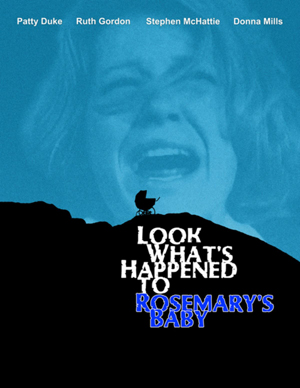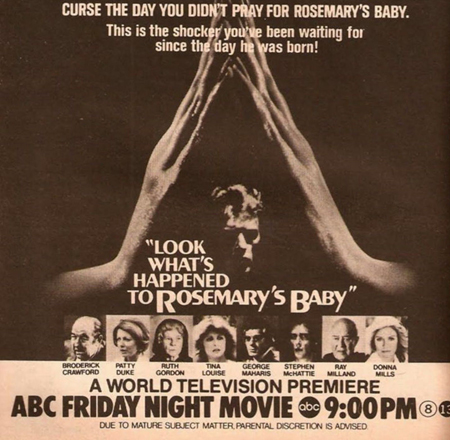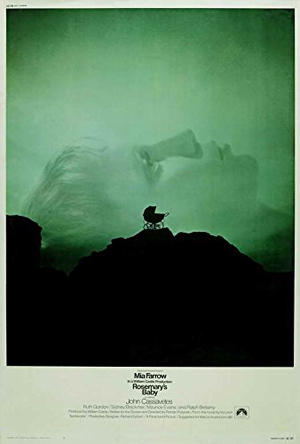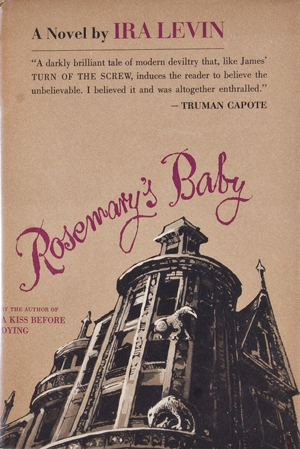Fantasia 2019, Day 5, Part 3: Look What’s Happened to Rosemary’s Baby
 It’s relatively unusual for me to watch a movie that I know going in is not good. But every so often, and usually at Fantasia, something bizarre comes along that looks bad but also in its way promising. So it was that for my third film of July 16 I settled in at the De Sève Theatre for a screening of the rare 1976 TV-movie sequel to Rosemary’s Baby: an opus directed by Sam O’Steen titled Look What’s Happened to Rosemary’s Baby. Star Stephen McHattie was in attendance, and would stick around to take our questions after the film.
It’s relatively unusual for me to watch a movie that I know going in is not good. But every so often, and usually at Fantasia, something bizarre comes along that looks bad but also in its way promising. So it was that for my third film of July 16 I settled in at the De Sève Theatre for a screening of the rare 1976 TV-movie sequel to Rosemary’s Baby: an opus directed by Sam O’Steen titled Look What’s Happened to Rosemary’s Baby. Star Stephen McHattie was in attendance, and would stick around to take our questions after the film.
(I had actually seen Rosemary’s Baby for the first time in preparation, and I was surprised how much I did not care for it. It was well-shot, and Rosemary’s isolation was captured well in the second half of the film. But it was difficult to believe in that isolation after we’d already seen her at a Christmas party with her friends. Atmosphere stubbornly resisted being evoked. The gothic material almost uniformly fell flat, and the Satanist coven came off as an unthreatening group of busybodies. I did not understand what was supposed to be scary in this movie, or what beyond craft was supposed to make it a classic. Disappointed as I was, I think now this viewing unwittingly set me up to be receptive to Look What’s Happened as a kind of unwitting satire, ruthlessly if unintentionally pointing out the weaknesses and absurdities of the original.)
The movie was introduced by Phlippe Spurrell of Montreal’s Cinéclub Film Society. He noted that the 35mm print came from the personal collection of Fantasia co-director Mitch Davis, and 7 or 8 hours had gone into the inspection, cleaning, and mounting of the film on a single reel. He warned us that some material was faded, but promised us surprises (which turned out to be period commercials inserted into the original commercial breaks of the film, for things like K-Tel albums and “newfangled Pringle’s Potato Chips”). Spurrell observed that O’Steen was the editor of Rosemary’s Baby, and John A. Alonzo was director of photography for both films. Ira Levin, writer of the original novel, was not involved, nor was Roman Polanski (who had scripted his adaptation as well as directed). Instead Look What’s Happened was written by Anthony Wilson, veteran TV writer and creator of shows like Banacek and one of the developers of the Planet of the Apes TV spin-off. (He also wrote what I thought was a fine episode of the original Twilight Zone, “Come Wander With Me.”)
 McHattie then spoke about why he took the film. He recalled coming off starring in a failed biopic of James Dean when he was offered Look What’s Happened, and thinking: “I only have two feet — I might as well shoot off the other one.” He remembered on his first day one of his friends also acting in the film asked him “What’re you gonna do with this piece of shit?” At the end of shooting, the same man said “I toldja,” and McHattie shot back “You didn’t fuckin’ help, did you?”
McHattie then spoke about why he took the film. He recalled coming off starring in a failed biopic of James Dean when he was offered Look What’s Happened, and thinking: “I only have two feet — I might as well shoot off the other one.” He remembered on his first day one of his friends also acting in the film asked him “What’re you gonna do with this piece of shit?” At the end of shooting, the same man said “I toldja,” and McHattie shot back “You didn’t fuckin’ help, did you?”
Before Look What’s Happened played, we were shown another of McHattie’s early-career highlights, a short film called “The Star Spangled Banner.” It’s a 5-minute non-narrative piece that won director Roger Flint a Grand Prize of the Jury for Best Short Film at the 1971 Cannes Film Festival, along with a nomination for a Palme d’Or. McHattie’s a soldier on patrol as an increasingly distorted and psychedelic version of “The Star-Spangled Banner” plays; he is shot, and falls in slow-motion, and images of home and faces of various Americans are spliced into the action. It’s not subtle, but probably resonant in 1971.
Then came Look What’s Happened to Rosemary’s Baby. As promised, it’s not a good film. And more precisely, it’s the sort of bad — the kind that has a few vaguely interesting ideas in it — that you can see how people could convince themselves that maybe, maybe, they could make something out of it. As it turned out, they couldn’t.
The movie’s divided into three parts, and picks up right where the Polanski movie left off. In that film, Rosemary Woodhouse was raped by Satan, set up by a coven of elderly Satanists who lived next door; her husband colluded with them, keeping her from realising there was anything out of the ordinary about her pregnancy, and so led her to give birth to Satan’s child. I note in bemusement that that movie is still taken perfectly seriously. At any rate, Look What’s Happened to Rosemary’s Baby follows on from there, and is divided into three parts.
 In the first, “The Book of Rosemary,” Rosemary Woodhouse (here played by Patty Duke) raises her child for a few years as ordered by the coven, led by Roman and Minnie Castevet (Ruth Gordon reprises her role as Minnie, while Roman is played by veteran actor Ray Milland). Then she tries to flee to her husband Guy (George Maharis), but the coven magically take a hand, arranging for a supernatural force to spirit away Rosemary while a prostitute named Marjean (Tina Louise, best known as Ginger from Gilligan’s Island) takes over raising the boy Adrian (Philip Boyer). “The Book of Adrian” follows, skipping ahead several years to find the son of Satan now a young adult (McHattie) as a low-grade rock idol with no knowledge of his true identity despite manifesting occasional terrifying powers. The coven hope he’ll become a host for Satan; there is a ritual; things go wrong. “The Book of Andrew” sees the devil’s son wake up in a prison hospital with amnesia, and flee with a beautiful nurse (Donna Mills). But are there deeper plans afoot?
In the first, “The Book of Rosemary,” Rosemary Woodhouse (here played by Patty Duke) raises her child for a few years as ordered by the coven, led by Roman and Minnie Castevet (Ruth Gordon reprises her role as Minnie, while Roman is played by veteran actor Ray Milland). Then she tries to flee to her husband Guy (George Maharis), but the coven magically take a hand, arranging for a supernatural force to spirit away Rosemary while a prostitute named Marjean (Tina Louise, best known as Ginger from Gilligan’s Island) takes over raising the boy Adrian (Philip Boyer). “The Book of Adrian” follows, skipping ahead several years to find the son of Satan now a young adult (McHattie) as a low-grade rock idol with no knowledge of his true identity despite manifesting occasional terrifying powers. The coven hope he’ll become a host for Satan; there is a ritual; things go wrong. “The Book of Andrew” sees the devil’s son wake up in a prison hospital with amnesia, and flee with a beautiful nurse (Donna Mills). But are there deeper plans afoot?
Well, yes, but it’s hard to call anything in this movie deep. There are some things American network TV in the 1970s was not able to handle, even when parental discretion was advised. A challenging treatment of religion and the role of the Devil, say. A willingness to explore the potential implications of a Satanic parody of Christ. Oh, and also there’s the issue of how genuinely horrific a TV-movie could be, not just in terms of gore or disturbing ideas, but simply in the sense of being scary.
Many of the creative choices are just baffling. The tripartite structure isn’t terrible, though having the adult Adrian (or Andrew) not come into his full power feels like a cheat. The Bible does create expectations for an Antichrist which, needless to say, go unmet. Of course the movie fails to build any tension around the possibility of Adrian becoming fully possessed by Satan, but more than that, it tends to undercut the horror of the first film by suggesting that the victory of evil was really not that significant after all, just a step in a bigger plan, and that there were a lot of things that could still go wrong. Not to give too much away, but by the end of the movie Satan’s significantly further back than he was at the start, and the geriatrics of the Satanic coven will have to face the possibility of not seeing in their lifetimes the diabolic apocalypse for which they’d been scheming.
 As it is, the movie retcons away the original movie’s implication that the Devil’s child is visibly sinister. He’s an average-looking kid, with occasional weird powers. (Worth noting that the occultists are given a little bit more power here than in the original, too, which naturally raises the question of why they’re bothering to spend years focussing on Adrian rather than try to further Satan’s will by using that magic power to change the world in any number of ways.) The idea of having Adrian grow into a rock star is one of those interesting ideas that comes to nothing; there’s no particular link made between rock n’roll and Satan or the occult. This Antichrist isn’t even a bad guy.
As it is, the movie retcons away the original movie’s implication that the Devil’s child is visibly sinister. He’s an average-looking kid, with occasional weird powers. (Worth noting that the occultists are given a little bit more power here than in the original, too, which naturally raises the question of why they’re bothering to spend years focussing on Adrian rather than try to further Satan’s will by using that magic power to change the world in any number of ways.) The idea of having Adrian grow into a rock star is one of those interesting ideas that comes to nothing; there’s no particular link made between rock n’roll and Satan or the occult. This Antichrist isn’t even a bad guy.
I can’t help but note the complete lack of interest in continuity with the original, too. Rosemary’s Baby made a big deal about the time it was set, ending with Adrian being born in June of 1966 — 6/66. Since we see Adrian as an adult (McHattie was 30 in 1976) that means a good chunk of the move is technically set in the 1980s or 1990s. (I asked McHattie about this after the film, and he confirmed nobody thought about the chronology on set; that’s the 1970s for you, really.)
This was a project that was doomed to failure. I can only imagine that this was greenlit in the wake of M*A*S*H* going from critically-acclaimed film to hit TV show, and somebody hoped lightning would strike twice. What is interesting about Look What Happened in its way is what time has done with the film. You can see the 1970s in it clearly, not so much in the fashions and technology and so forth (though you see them there, too) as in the way it was made. The camera angles, the soundtrack, the dialogue — they’re all out of 1970s television. What must have seemed dull and generic when the movie aired seems now hilariously archaic.
The actors try their best, and McHattie does a good job. Had he been given any kind of a script he’d have had a puncher’s chance. But there’s nothing for him to work with, and the barely repressed anger and potency he projects is too easily read at fury at the movie he’s stuck in. Other actors are competent — in total fairness, I didn’t place the name ‘Tina Louise’ when I saw it in the credits and her performance did not remind me of Gilligan’s Island at all. So there’s that. But then there’s Ruth Gordon, and while she’s amusing, hectoring her husband and anybody else in sight, she does help destroy any chance the film had of creating a sinister tone.
 Not, again, that it had very much. As I said, though, there are some interesting ideas. The tripartite structure is potentially interesting. The Satanic bus that carries Rosemary away forever is also a potentially interesting horror idea that’s wrecked by poor staging and a lack of atmosphere. The idea of the son of Satan being raised by a prostitute, a kind of contrast to both the Virgin Mary and Mary Magdalene, could have been useful; it isn’t, not least because the film’s very coy about the character’s profession. Above all, there’s a surprisingly cruel scene near the end where Adrian’s raped in a way that precisely parallels the rape of Rosemary in the original. It’s the only thing in the movie that refers to the original in a clever way, and one of the few things that creates anything like a sense of horror.
Not, again, that it had very much. As I said, though, there are some interesting ideas. The tripartite structure is potentially interesting. The Satanic bus that carries Rosemary away forever is also a potentially interesting horror idea that’s wrecked by poor staging and a lack of atmosphere. The idea of the son of Satan being raised by a prostitute, a kind of contrast to both the Virgin Mary and Mary Magdalene, could have been useful; it isn’t, not least because the film’s very coy about the character’s profession. Above all, there’s a surprisingly cruel scene near the end where Adrian’s raped in a way that precisely parallels the rape of Rosemary in the original. It’s the only thing in the movie that refers to the original in a clever way, and one of the few things that creates anything like a sense of horror.
And of course it’s nowhere near enough. Still, it has to be said, I was entertained. That’s entirely because I was watching the movie in the context of Fantasia, with a near-full house, and an audience primed to laugh at the unintentional ludicrousness of it all. If you’re watching it without a crowd, I can’t imagine that it’d be especially pleasant. But at least for that one screening, the movie brought some pleasure to a bunch of people. You take what you can get, I suppose, and for me the entertainment I got at the screening made up for the tedium of watching the original Rosemary’s Baby. I don’t imagine those words have ever been set down in that order before, but the world brings something new every day.
Stephen McHattie came out to take questions after the film. I can’t hope to capture here the tone in which he spoke of the movie. Fortunately, I don’t have to. My redoubtable colleague Giles Edwards of 366weirdmovies.com recorded the Q&A. You can find it appended to his review, or on its own on YouTube. I recommend it, not just for McHattie’s reflections on Look What’s Happened to Rosemary’s Baby, but for his thoughts on the “Star Spangled Banner” short and the atmosphere of the times.
It was, in all, a fun evening. And I still had another movie to go before my night was done. Which would be a much odder thing.
Find the rest of my Fantasia coverage from this and previous years here!
Matthew David Surridge is the author of “The Word of Azrael,” from Black Gate 14. You can buy collections of his essays on fantasy novels here and here. His Patreon, hosting a short fiction project based around the lore within a Victorian Book of Days, is here. You can find him on Facebook, or follow his Twitter account, Fell_Gard.
I managed to introduce myself to Stephen McHattie — either before this movie or “Dreamland” — and I was impressed (in hindsight) how intimidated I was by him. I found myself really clawing for remarks as I stood and made a hash of an introduction. He was all very laid-back, and not unfriendly, I just lost my cool.
Outside of Canada, there is only a handful of specific kinds of people who would recognize his name; but I had more of a visceral reaction to his presence than I did some years ago when I met a young actress named Annie, who was nearing the peak of her popularity, when I was back at college. So yes, there’s something about McHattie — despite (because?) of having shot both his feet so early in his career.